There are advantages but there’s also a price to pay for having a bald head.
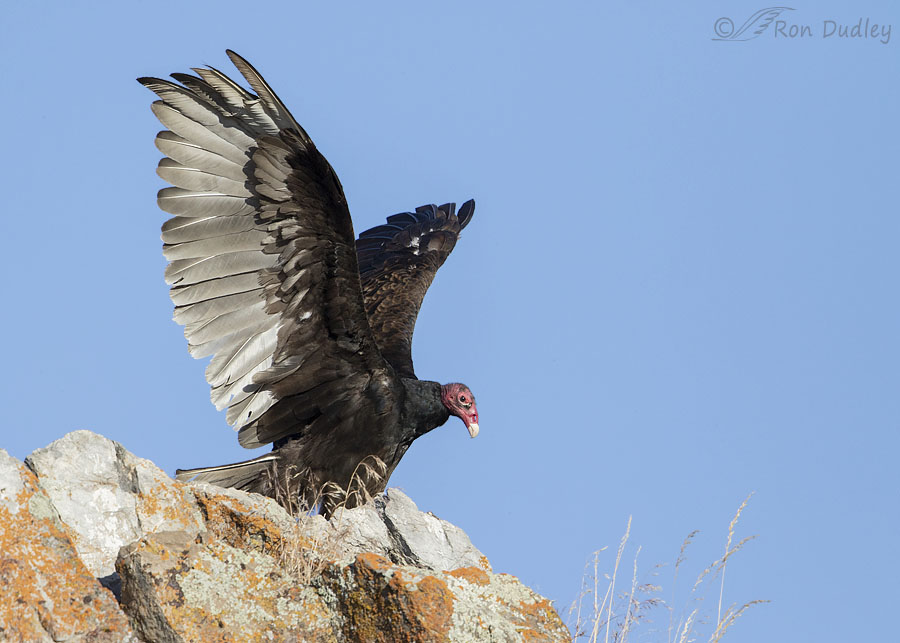
1/2500, f/6.3, ISO 800, Canon 7D Mark II, Canon EF 500mm f/4L IS II USM + EF 1.4 III Extender, not baited, set up or called in
Two days ago I found two Turkey Vultures on top of a small cliff and this one performed a slow, languid wing lift that lasted so long I was able to get 50 shots of it from beginning to end. This isn’t a takeoff posture, the bird didn’t take off until much later.
After this vulture left I was able to….
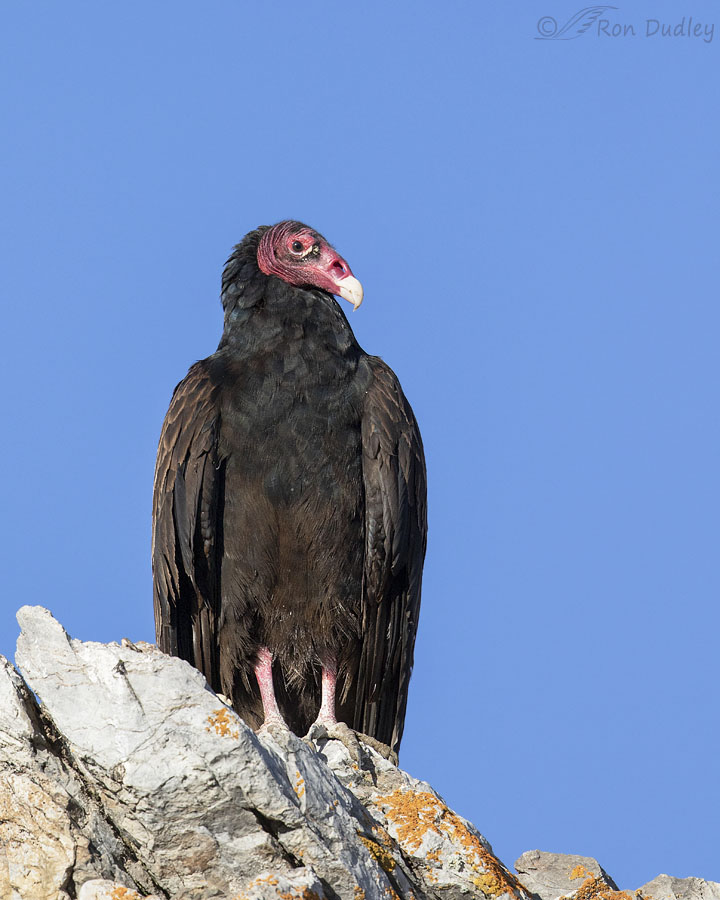
1/2000, f/6.3, ISO 500, Canon 7D Mark II, Canon EF 500mm f/4L IS II USM + EF 1.4 III Extender, not baited, set up or called in
get much closer to the second vulture – close enough that I had to shoot vertically.
But what these photos don’t reveal is the torment and torture being inflicted on both vultures by biting gnats. Both birds were vigorously shaking/tossing their heads every 3-5 seconds with no breaks at all. Apparently the gnats could only get at their heads because feathers protected the rest of their body and scales protected their feet and toes.
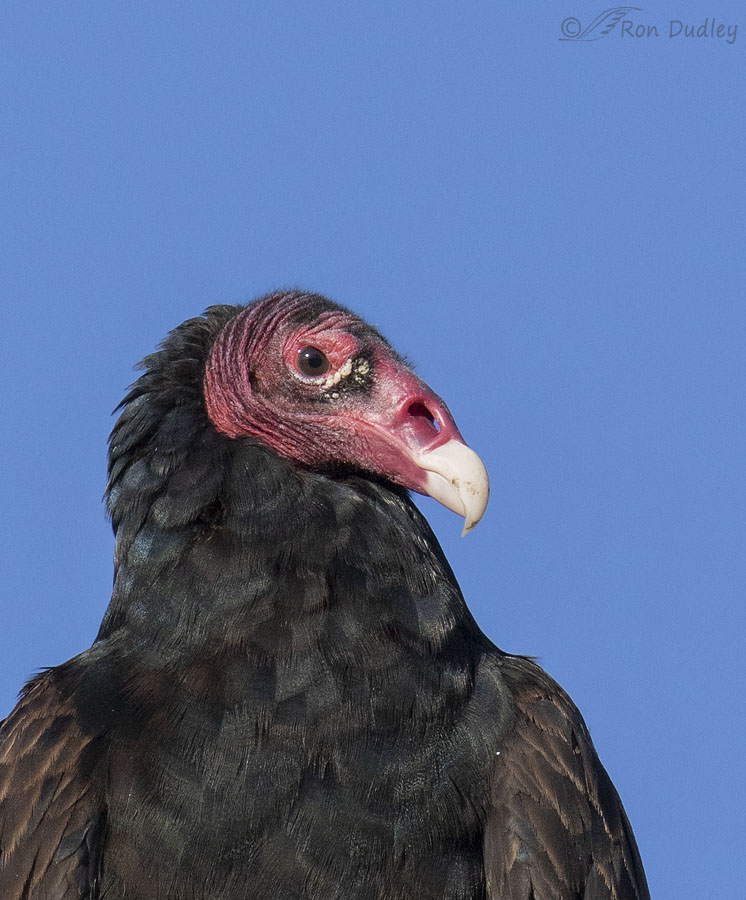
But their heads are bare skin and vulnerable to insect attack (although I think if I were a gnat I wouldn’t go near a head that ugly…).
While I was taking these photos I really identified with these poor birds because my head is largely bald too and my scalp was crawling with those little bastards. But I couldn’t shake my head or swipe them away with my hand because I was trying to take photos so I just had to grin and bear it.
Misery loves company I guess.
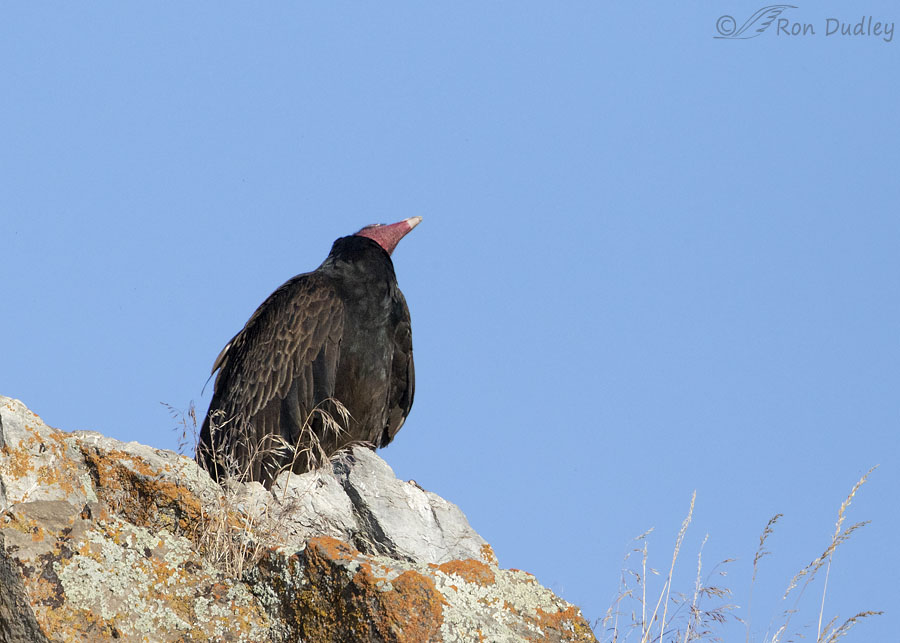
1/5000, f/6.3, ISO 800, Canon 7D Mark II, Canon EF 500mm f/4L IS II USM + EF 1.4 II Extender, not baited, set up or called in
I always tried to time my shots in-between head shakes and tosses so this was the only photo I got of one of the vultures tossing its head. I wish we could see the gnats in the photos but they’re just too damned small. They’re called “no-see-ums” for very good reason.
Most other birds don’t have this problem, at least not to this extent, because their heads are feathered. A while later that same morning and only a few hundred feet from where I was photographing these vultures I spent a long time photographing the female rufous Red-tailed Hawk I posted photos of yesterday. She showed no outward signs of being the least bit bothered by gnats even though I’m sure they were buzzing all around her.
Here she is in a photo taken earlier this spring as she was taking off from a cliff. It’s a large crop so the image quality isn’t very good but we can see why gnats would have a difficult time getting through her defenses.
Good luck damned gnats, getting through that plumage barrier!
Ron
Note: For years experts have assumed that the reason most vultures have bald heads is to prevent the spread of microbes and disease when they stick their heads into rotting carcasses. But there may be more to it than that. Recent research has suggested that another reason their heads and often their necks lack feathers is for thermal regulation. More info here if you have the interest.


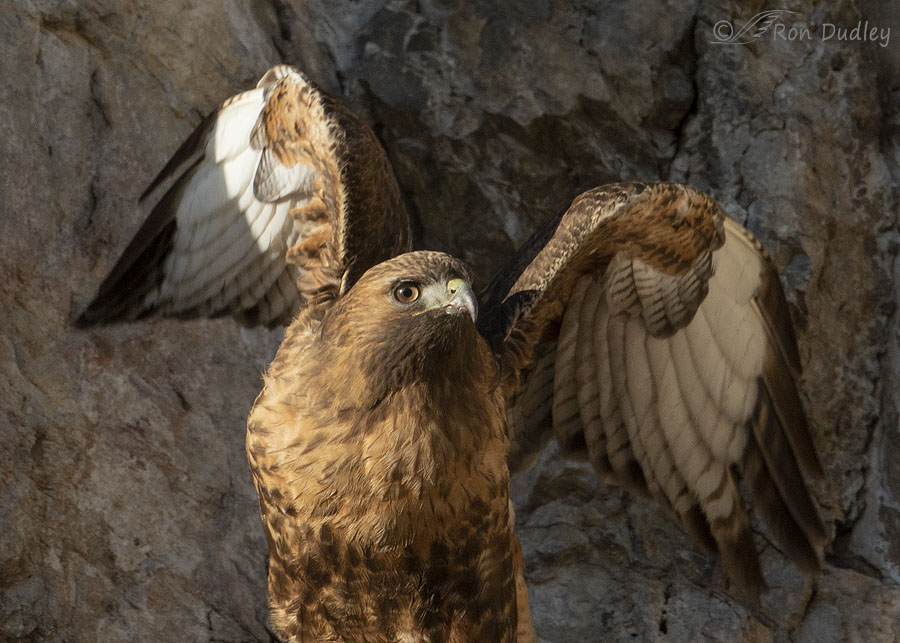
When it’s time for me to be recycled, my preference is to be left out for the Turkey Vultures. Since my physician prescribed topical diclofenac for a hurt knee, I was concerned that I might harm them. Good news! It turns out that old world vultures are affected, but Turkey and Black Vultures are not. If I can simply manage to croak in North America during the summer, the plan is solid.
I loved your comment, Mikal. When I was teaching I always tried to remember that a lesson that included humor is always better remembered. Your comment included both.
Keep a cool head-like a vulture. I found his portrait rather stately-looking rather than ugly which surprised me. One thing I think is absolutely beautiful is seeing them soar on a thermal.
I agree on both counts, Jane.
For some reason the eye catch of the Turkey Vulture in the third photo causes me to see the intelligence and dignity of these birds. Exceptional photos and post. BTW, the comment about African vultures reminds me of vultures in India that involves sacred cows, dlclofenac (which is toxic to the vultures there), and rabies, that shows their importance in the ecosystem there.
Biting gnats, cutters in their mouths, blood sucking: sounds like a plot for a sci-fi/horror flick.
“Diclofenac” – I had to look that one up, Lyle. Maybe I should try it for my back since it’s a nonsteroidal anti-inflammatory drug.
But it’s deadly to vultures. In some parts of India and Southeast Asia it has killed more than 90% of the vultures. The vulture digestive system destroys rabies. With the vultures gone, wild dogs are now the main scavenger and they are not immune to rabies. Now in India, each year.over 15 million people are bitten by dogs and need protection from rabies and more than 25,000-30,000 people die from rabies. Contrast that with the U.S. where only 0-3 people die from rabies each year.
Looks like I haven’t kept up on my vulture news. Thanks for the explanation, Dan.
Late to the party (I was out at first light freezing soap bubbles and photographing them).
I mourn that we don’t have vultures. Given the obscene amount of road kill on our country roads they would perform a much needed service. And loved seeing yours – and learning about the clever adaptation they have made to thermo-regulate. Keeping their heads cleanish has to be another bonus.
Lovely to see your beautiful friend again too. And to learn that she is triumphant over bitey bugs.
I’m curious, EC. Do you have any vertebrate Aussie scavengers that perform a function similar to the role played by vultures?
Many of our birds and animals are opportunistic feeders and will certainly eat carrion when they come across it. Ravens and the raptors. Dingoes. Goannas. Insects in plenty.
I don’t think we have any that only eat carrion.
Interesting. Thanks, EC.
Very jealous of those of you who get to see TVs on the reg, especially large committees of them. I used to see them as having a face “for radio” or “that only a mother could love,” but the more I learn about them and see them, the more enchanting I find their downy pates.
The wing lift shot is pretty spectacular! Not sure if there’s something going on with the 2nd primary, as it looks to be shorter as if part broke off.
Sorry you both had to deal with the noseeums. I’ve often wondered if vultures/condors could use mud packs (like elephants do) to help protect their heads against biting insects. I would think that once the mud dries, it could be removed much the same way dried tissue is. Of course, this presumes they could find the right kind/texture of mud, that it wouldn’t interfere with thermoregulation, that they could remove it, or if it would even work. Just the odd tangents my mind travels…
The shaft of this feather appears longer than the vanes, so somehow the vanes have been damaged and stripped away. Not sure how that would happen. Perhaps the feather broke near the tip and pulled away some of the vane.Technically, this is the 9th primary, not the 2nd. By ornithological convention, the primaries are counted from the wrist outward and secondaries are counted from the wrist inward. Not that this matters for us to understand what you are referring to, just the terminology you would find in an ornithology textbook or other references.
Cool! Thank you for more interesting info to build my ornithological knowledge. I never knew about the counting — I had actually assumed the opposite (secondaries from the body out and primaries from the end of the wing in).
I never knew about the counting — I had actually assumed the opposite (secondaries from the body out and primaries from the end of the wing in).
They’re fun birds to have around, Marty. I always look forward to seeing them again in spring. They’re easy to spot while soaring so especially in spring I’m always looking for them as I drive home from my bird forays.
“Beauty is in the eye of the beholder.” I have always thought Turkey Vultures looked regal. The Red-tail is a stunner too.
April, IMO the TV looks regal despite its ugly head, not because of it…
I’m a fan of vultures. I love their ugly heads. My husband is bald too. Hmmm, maybe I shouldn’t mention the similarities.
Nothing wrong with being bald as long as you have a handsome head and a few fully functional synapses underneath where there used to be hair, Arwen!
My hubby is also follicularily challenged (and I think he’s really smart too). I just figure that all that brain power he has simply pushed his hair out of the way. Besides, as my mom used to say, “Who wants fat hair.”
Besides, as my mom used to say, “Who wants fat hair.”
I think I’d like your mom, Marty.
Both she and my dad were quite the cards. I’m sure they both would have become fast friends with you.
I am so privileged to be able to follow your bird blog Ron. You are a natural teacher, and I’ve only met a few of those. With your wonderful pictures and enlightened stories, I can become the bird and imagine life from their point of view. You are a magician.
Very kind of you to say so, Sheri. I always felt lucky that I stumbled into teaching as a profession.
VERY interesting shots and commentary so far! I noted their eyes are kind of vulnerable sticking out the way they do.??? Not a “featured bird” in our area and, fortunately, we rarely have no-see-ums. Clean up from storms continues – know one area of wheat flattened – rest is a wait and see tho from all the “brown spots” on the tall grasses around it’s probably not good.
I noted their eyes are kind of vulnerable sticking out the way they do.??? Not a “featured bird” in our area and, fortunately, we rarely have no-see-ums. Clean up from storms continues – know one area of wheat flattened – rest is a wait and see tho from all the “brown spots” on the tall grasses around it’s probably not good.
I don’t recall seeing vultures on the MT farm either, Judy. There’s a few unusual-looking “bites” taken out of their range map in that general area so maybe that explains it.
Despite the bald head (think what a robin would look like without head feathers), Turkey Vultures are one of my favorite birds. That wingspread is important in the morning. They lower their body temperature by as much as 9°C each night. Spreading the wings and orienting to maximize sunlight helps with the warmup process. The bald head also helps absorb some heat, and later in the day can help disperse heat in higher temperatures. As a primary scavenger the bald head does help prevent blood and dead tissue from building up and it is much easier to clean off: the sun dries the residue and makes it easier to scratch off with the feet and head-preening can only be done with the feet. Turkey Vultures are often the first scavengers into a large carcass. They gain access through the wound or through the anus. Note that many other scavengers, such as Bald Eagles, step back and wait for the vultures to open the carcass. With a now larger opening, their exposure to blood and dead tissue is thus reduced and they have less to clean up.
The black color also plays a role in thermoregulation besides warmup in the morning. Note that crows, ravens and other all black birds also may live in hot climates. The feathers are held slightly away from the body and not pressed tightly to the skin. As they absorb sunlight, the feathers increase their temperature. This helps setup a thermal gradient that draws air under the feathers and over the body. This current of air helps remove heat from the body. The black feathers absorb more heat than a lighter color creating a stronger gradient that is more efficient at providing temperature regulation.
There are many other special adatpation that make Turkey Vultures fascinating birds to study. And they play an extremely important role as the clean-up committee in our environment.
Thanks, Dan. That info about the temperature gradient was completely new to me but it makes perfect sense.
Dan, thank you for another fascinating lesson about birds. I also had no idea about black feathers and thermal gradients.
Amusing post with very nice photos! I really feel for the poor bird. Thanks once again for your original take on all things “nature”… nothing like sitting back enjoying a Sunday morning cuppa coffee and playing blog catch up on all your blog entries.
I’m glad you’re enjoying the process of catching up, Joanne. And coffee always helps in the mornings…
Poor vultures……I wonder if there’s residue of their meals clinging to the skin and caught inside the wrinkles of their heads–that would attract the no-see-ums even faster…..
Vultures perform such a valuable service to their environs–I hate to see them vulnerable to that torture,,,,,,
I dunno, Kris but I doubt it. Biting gnats have four ‟cutters” inside their mouths that slice the skin open so they can suck your blood. So it’s blood they’re after…
Really good photos Ron. Whenever I am looking or photographing these ugly guys and gals I am reminded that in nature there is a place and job for every creature. Yes, now we are into that time of the year that nature photographers have to remember to spray on the mosquito repellent and constantly be swatting at something. I was trying to hold steady while waiting for an eagle take off the other day and the whole time I am swatting various insects away from my face. Very annoying, but I guess part of the job.
Everett Sanborn, Prescott AZ
PS: Turkey Vultures spend considerable time warming up in the morning before going out. There is a location here at Granite Mountain where over twenty of them meet every morning on two or three old snag trees. They will sit there stretching out their wings for quite a while and then start to do short flights from tree to tree and then a little longer, and then finally they will all start to take off to do their cleanup work.
Thanks, Everett. Thermoregulation is a large part of vulture life, especially with that almost black plumage in hot climates.
Ron, I found your blog today so interesting. Love your photos (& I’m always glad to see one of that beautiful RTH!!) You have talked about the nasty “no-see-ums” before & I feel for both you & the Vultures. When do they show up in the area & for how long?! I don’t know if you saw this recent post on FaceBook – there are poachers in a certain area of Africa that are lacing their kills with poison to kill the Vultures because they alert the park ranges of their presence too soon. They are killing Vultures in huge numbers. Just disgusting!!
Jo Ann, how long those gnats hang around depends on the weather. Once temps have reached the mid-90’s consistently they usually disappear. And yes, I’ve heard about what’s going on with those poachers and African vultures. Disgusting.
They are a strange lot for sure. I never thought how that bald head would be a detriment for them but pairing it with gnats..it would be like an itch you just cannot reach. Interesting article. I see them often standing around with wings up and out-stretched near a marina where they gather in the summer just cooling. It’s a good place for them as there are cliffs nearby where they catch the rising thermals. I’ve counted as many as 70 birds in a pair of huge cottonwood trees when they return to the area in the spring.
Kathy, there can be large congregations of vultures in this general area too but I don’t believe I’ve ever seen anywhere near 70 of them at the same time. About half that is probably closer to what I’ve seen.